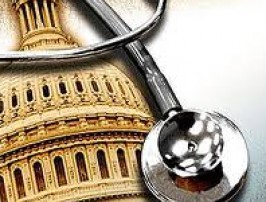How the Supreme Court Could Rule on the Affordable Care Act
On Nov. 10, the U.S. Supreme Court will hear arguments on whether the Affordable Care Act (ACA) is constitutional, in whole or in part. The court is expected to rule on the matter before its term ends in June 2021.
Only those justices sitting on the court when the case is heard will vote, and it is not yet known if a new Supreme Court justice will be confirmed when the case is argued. A vacancy on the nine-justice court was created by the death of Justice Ruth Bader Ginsburg on Sept. 18.
In the meantime, "the health care law remains fully in effect during the litigation, including all employer coverage obligations and reporting requirements," said Chatrane Birbal, vice president of public policy at the Society for Human Resource Management.
Complex Case History
The Supreme Court's options for deciding this case are shaped by the complicated history of litigation over the ACA.
The origins of the case go back to 2012, when the court upheld the constitutionality of the ACA's penalty on individuals who lack health coverage—the so-called individual coverage mandate—as a justifiable exercise of Congress' power to tax.
In December 2017, however, President Donald Trump signed into law a tax bill that eliminated the ACA's penalty on individuals who lack health coverage. Afterward, several Republican state attorneys general, led by the state of Texas, filed a lawsuit arguing that the health care statute itself, or at least the parts of the act closely linked to the individual mandate, were no longer valid. Democratic states and the House of Representatives, led by Democrats, stepped in to defend the statute.
In December 2018, a Texas district court struck down the ACA but stayed its ruling pending appeal, concluding that the individual mandate is so connected to the law that Congress would not have passed the ACA without it.
On appeal, in Texas v. United States, a split panel of the 5th U.S. Circuit Court of Appeals deemed that the individual mandate was unconstitutional, but the panel instructed the district court to rehear the matter and "to employ a finer-toothed comb on remand and conduct a more searching inquiry into which provisions of the ACA Congress intended to be inseverable from the mandate."
However, on March 2, 2019, before the district court could carry out the appellate court's directive, the Supreme Court announced it would hear the case in its term beginning in the fall of 2020, blocking the lower courts from taking further action.
5th Circuit Ruling Was Narrowly Focused
When the 5th Circuit instructed the district court to rehear the matter and to focus on those ACA provisions that Congress intended to be "inseverable from the individual mandate," this suggested, legal analysts said, that the appellate court was unlikely to overturn the ACA in full.
"Only the individual mandate was declared unconstitutional, and the portion of the lower court's decision invalidating the rest of the Affordable Care Act [was] vacated," according to an analysis of the appellate ruling by Segal, an HR consultancy. As a result, "plan sponsors know that the entire Affordable Care Act will not be overturned."
Had the case proceeded at the appellate level, the 5th Circuit might have struck down those parts of the law directly related to the individual mandate. The appellate decision noted, for instance, that community rating, which prevents insurers from varying premiums within a geographic area based on age, gender, health status or other factors, might be among the provisions determined to be "inseverable" from the individual mandate, because the increase in revenue to insurers from the mandate was meant to offset the decrease from these restrictions.
The ACA's guaranteed-issue provisions, which ban insurers from rejecting coverage based on a person's pre-existing conditions, might also be inseverable, the appellate decision noted.
Supreme Court's Options
The Supreme Court has the following options when it decides the case, The Washington Post and other sources have reported:
- To dismiss the case on technical grounds, leaving the statute in place. The court could decide, for instance, that Texas and the individual plaintiffs lacked standing to bring the lawsuit.
- To affirmatively uphold the ACA.
- To uphold the statute while finding the individual mandate to be void without its penalty, essentially maintaining the status quo.
- To uphold the statute but void both the individual mandate and other provisions closely linked to the mandate.
- To strike down the law in full, although that option has been viewed as unlikely by legal analysts. Should it happen, however, the effect of the ruling would likely be delayed, giving Congress the opportunity to correct the statute's constitutional defects or to pass a replacement health care law.
According to an analysis by the nonprofit Kaiser Family Foundation, "If the Supreme Court adopts the position that the federal government took during the trial court proceedings and invalidates the individual mandate as well as the protections for people with pre-existing conditions, then federal funding for premium subsidies and the Medicaid expansion would stand, and it would be up to states whether to reinstate the insurance protections."
If that were to happen, Congress also could reinstate protections for people with pre-existing conditions.
Joe Biden, the Democratic presidential nominee, has voiced his support for the ACA, sometimes referred to as Obamacare, pointing out how it safeguards people who might not otherwise qualify for coverage. His campaign website says, "Because of Obamacare, over 100 million people no longer have to worry that an insurance company will deny coverage or charge higher premiums just because they have a pre-existing condition—whether cancer or diabetes or heart disease or a mental health challenge."
President Trump has also pledged to maintain these protections even as his administration supports the lawsuit that seeks to overturn the act. During his acceptance speech for the Republican presidential nomination, Trump said, "We will always, and very strongly, protect patients with pre-existing conditions, and that is a pledge from the entire Republican Party."
In Case of a Tie Vote
"If the case is heard by the current eight justices and results in a 4-4 vote, the justices could reschedule oral argument or delay consideration until [Texas vs. United States] can be reheard by a full Court," wrote Katie Keith, a former research professor at Georgetown University's Center on Health Insurance Reforms and a contributor to the Health Affairs blog. "This might mean Texas would be reheard later in the spring depending on the timing of confirmation."
Alternatively, "the Court could issue a 4-4 ruling, which would maintain the status quo and leaves the appellate decision intact. In this instance, the 5th Circuit's ruling would stand and the case would be remanded back to the district court," she noted.
If that is the outcome, "the ACA would remain in effect while the district court undertook a provision-by-provision severability analysis," Keith noted. "The litigation would continue for years as we await a new district court decision, another appeal to the 5th Circuit, and most likely a return to the Supreme Court."
|
Thinking Ahead "Employers will be wise to give some thought to how they might react to different outcomes, Mercer, an HR consultancy, advised. "For example, if some common provisions eliminated by the ACA like annual/lifetime dollar limits on essential health benefits, ending dependent coverage at age 19/23, or the previously mentioned pre-existing condition exclusions were permitted again, would an employer reshape their plan design to curb costs? If the employer 'play-or-pay' mandate (the 30-hour rule) were struck down, would an employer move full-time eligibility back to 40 hours?" Concluded Mercer's consultants, "There is much to consider with these possible ACA changes," should they come to pass. |
SOURCE: Miller, S. (23 September 2020) "How the Supreme Court Could Rule on the Affordable Care Act" (Web Blog Post). Retrieved from https://www.shrm.org/resourcesandtools/hr-topics/benefits/pages/how-the-supreme-court-could-rule-on-the-affordable-care-act.aspx
Viewpoint: How to Minimize the Risk of Retirement Plan Litigation
Many employers have paid millions to settle lawsuits brought to them based on their excessive fees in their retirement plans. It's the employer's responsibility to ensure that retirement plans are created for the most benefit for those who partake in it. Read this blog post to learn more.
What do Estee Lauder and Costco have in common? Both are defending themselves against lawsuits alleging mismanagement of 401(k) accounts, as retirement plan litigation under the Employee Retirement Income Security Act (ERISA) proliferates.
LinkedIn was added to the list in August, when a class-action lawsuit was filed alleging the firm mismanaged its 401(k) plan. And, on Sept. 18, a federal judge rejected a petition by AutoZone Inc. to dismiss allegations of ERISA violations filed by 401(k) plan participants.
In recent years, employers as different as Princeton University and WalMart have paid millions of dollars to settle lawsuits brought by employees alleging excessive fees in their retirement plans.
At the heart of many of these cases are allegations that employers' retirement plan oversight committees tolerated high fees and poor investment performance. Retirement plan committee members are fiduciaries who, under ERISA, are responsible for ensuring that the plan operates in the best interest of its participants.
Attracting Lawsuits
Companies settling ERISA lawsuits are typically accused of failing to pay adequate attention to the retirement plan, such as by failing to remove or replace poor or overly expensive investment choices and allowing vendors to charge above-market fees. The old adage that an ounce of prevention is worth a pound of cure is relevant here.
Law firms are combing through ERISA plan annual filings to identify worthwhile 401(k) targets, looking for expensive or poorly performing investments and high recordkeeping costs. ERISA complaints now include tables and charts comparing a targeted plan's investment performance and expenses with average or best-available practices, to persuade courts that a trial is in order.
Law firms comb through ERISA plan filings to identify worthwhile targets.
Adopting Best Practices
Plan sponsors can't completely eliminate the risk that they will be sued by current or former plan participants, but companies can minimize the risk by adopting best practices—such as those listed below—for making plan investment and management decisions.
FORM AN ACTIVE RETIREMENT PLAN OVERSIGHT COMMITTEE.
The committee should include interested employees, including representatives of HR, finance, legal and rank-and-file employees. A well-functioning committee has a range of talents and perspectives to help it make effective decisions.
The committee should operate under a written charter, setting out the responsibilities of the committee and its procedural rules for appointing members, holding meetings, voting, and hiring advisors and experts as needed, for example. The charter need not be overly rigid or specific but should be drafted to reflect how the committee will operate.
PROVIDE PERIODIC FIDUCIARY TRAINING FOR COMMITTEE MEMBERS.
ERISA is complicated, and committee decisions have direct impacts on employees' retirement income. Committee members must act solely in the interest of plan participants and make decisions as a "prudent expert." Ask vendors to have their top technical experts conduct training, and ensure that the training is tailored to plans of your size.
WRITE AND ADOPT AN INVESTMENT POLICY STATEMENT.
While having an investment policy statement (IPS) is not generally a requirement for 401(k) plans, it is an important document as it may help show that the committee acted prudently and in the plan's best interests in evaluating investments. The IPS should include specific language describing the process by which investments are selected, monitored and replaced when necessary.
It is not advisable to list the plan's current investments within the IPS, as this list may change over time and the IPS may not always be consistent with the website your participants visit to manage their accounts.
MINIMIZE INVESTMENT FUND EXPENSES.
Sponsors of 401(k) plans have spent millions of dollars settling allegations that they had overly expensive funds, in many cases retail-share classes rather than institutionally priced investments.
The expense ratios that 401(k) plan participants incur for investing in mutual funds have declined substantially since 2000, reports the Investment Company Institute, a trade association for financial services firms. In 2000, 401(k) plan participants incurred an average expense ratio of 77 basis points (0.77 percent) for investing in equity mutual funds. By 2019, that figure had fallen to 39 basis points (0.39 percent), which is a 49 percent decline.
For plan sponsors of all sizes, it is imperative to document efforts to maintain the lowest possible investment expenses.
COMPARE INVESTMENT PERFORMANCE.
How do your plan's funds compare to similar offerings? There is no shortage of high-performing, low-expense funds to choose from in each investment category. While the retirement committee can't forecast future investment performance, it can determine prudent funds based on their track record.
If investment evaluation isn't your forte, get expert help from an investment adviser that accepts fiduciary responsibility for investment recommendations.
DROP UNDERPERFORMING FUNDS.
If the menu needs to be revamped, just do it. The small inconvenience of explaining to employees why changes are being made is better than responding to document requests arising from litigation for failing to let go of underperforming funds.
MONITOR REVENUE-SHARING.
Many mutual funds share a small portion of their expense ratio fees with plan administrative firms, which may reduce the costs that plan sponsors pay administrative firms for services such as recordkeeping of participants' investments, providing statements and distributing literature. Fund share classes with no revenue-sharing, however, have lower expense ratios and slightly better investment performance.
If revenue-sharing is in place for any fund being offered through the plan, audit it periodically—at least annually—and ensure that it is reducing plan expenses that might otherwise be paid by participants.
PAY VENDORS WITH FLAT-DOLLAR FEES.
All plans should grill their recordkeepers and other vendors on whether they charge the very lowest administrative fees available. When plan sponsors don't pay administrative fees themselves, a best practice is to charge participants a flat recordkeeping fee (perhaps subsidizing small balances) rather than using revenue-sharing funds to pay the recordkeeper a fee based on the percentage of assets in plan accounts.
If plan sponsors engage an investment adviser, it's also preferable to pay them a flat-dollar fee rather than a fee that fluctuates based on plan assets. Advisers should not be thinking about how recommended changes in a fund lineup will affect their pay.
In all circumstances, evaluating fees on a flat-dollar amount or dollars per participant will provide useful comparisons to fees based on a percentage of assets under management in the plan.
MAINTAIN CONSTANT VIGILANCE ON ADMINISTRATIVE FEES.
Recordkeepers and other vendors negotiate best when they perceive that they may lose you as a customer. As a fiduciary, you and your team need to play hardball at times. Don't worry about hurting the feelings of the vendor's personnel—you're the fiduciary with potential liability, they're not. Benchmark your administrative fees and consider issuing a request for proposal (RFP) for administrative services every few years.
Even though plans may not have changed much, vendors have, and they should be able to lower costs or provide additional services.
DOCUMENT YOUR DECISIONS, BUT BE SMART ABOUT IT.
Maintaining good records is a must but understand that any and all plan-related documents can wind up in the hands of class-action attorneys. Meeting minutes and e-mails should be carefully written and demonstrate a prudent process, to avoid casting the plan or committee in a bad light.
GET IT IN WRITING.
Vendor contracts should be negotiated, not rubber-stamped. Keep track of promises made in RFP responses and finalist presentations. A vendor's oral promises should be documented within their service agreement. Insist on performance guarantees so your plan will be compensated for any service lapses.
DON'T ACCEPT FORCED ARBITRATION WITH ANY VENDORS.
Fiduciaries should not sign away their option to use federal courts to resolve conflicts with vendors. Plan sponsors can always choose to arbitrate a dispute, as vendors prefer this. Just don't sign any contracts agreeing to compulsory arbitration of any and all disputes.
PROTECT AGAINST IDENTITY THEFT.
Ensure that hackers don't steal your employees' account balances. Ask recordkeepers about their security practices, experiences in defeating hackers, and resources committed to maintaining strong cybersecurity.
Obtain a written commitment in the service agreement that the vendor will reimburse participants who followed account security guidelines and, through no fault of their own, had their accounts depleted.
Summing Up
There are several things a company can do to protect against 401(k) litigation. Have the retirement plan run by a committee of dedicated, knowledgeable employees. Hire independent expert advisers to help with investments, vendor oversight and training. Make sure that all fees are competitive, using benchmarking and RFPs as needed. Use an objective fund scoring methodology and replace underperforming investments. Document decisions and pay attention to process.
SOURCE: Scott, P. (22 September 2020) "Viewpoint: How to Minimize the Risk of Retirement Plan Litigation" (Web Blog Post). Retrieved from https://www.shrm.org/resourcesandtools/hr-topics/benefits/pages/minimize-risk-of-retirement-plan-litigation.aspx
5 open enrollment communication strategies for your remote workforce
As the employee benefits workforce continues to stay remote in a majority of places, it's important for them to strategize their communication especially as open enrollment season is coming around the corner. Read this blog post for helpful tips.
Even before the COVID-19 pandemic forced many employers to switch from a mostly onsite workforce to a remote or dispersed workforce, employers were faced with effectively and consistently communicating benefits to employees who were located in different locations, whether that meant offices in different cities or countries; work from home employees; employees working in warehouses, factories, and distribution centers; or employees working at different branches of retail or service businesses.
This communication is important because when employees are unaware of what benefits are available or don’t know how to access their benefits, utilization can drop significantly, so neither employees nor employers are getting value from the benefit offerings. In addition, when employees aren’t using or aware of their benefits, satisfaction with employers decline, which can impact both productivity and retention.
The goal is to both effectively and continuously communicate with employees and build awareness and understanding of available benefits, not just during open enrollment, but all year long. Of course, each communication strategy will be shaped by the organization’s culture, but there are several tools that employers should consider including in their benefits communication toolkit.
Diversify your benefits communication tools
Before developing your benefits communications plan, determine how employees prefer to receive this information by surveying them. In most organizations, there will be several different approaches that appeal to employees because of differences in employee ages, locations (office vs. warehouse or delivery truck), and comfort level with technology.
In the past, standard benefits communications were printed materials that were either distributed at work or mailed home. And while this tool is still effective and gives employees something they can use as a reference throughout the year, there are several other tools that employers should consider using to reach their diverse employee audiences.
Dedicated benefits websites and/or mobile apps broaden access to information
Unlike printed materials, with an online benefits site and mobile app employees can access the content wherever they are, whenever they want, and employers can update the information frequently without incurring printing costs. The site can also serve as a convenient way for employees to ask benefits questions, which can be answered by email from an HR team member, a benefits vendor’s support team or for simple, frequently asked questions, by a chatbot.
Email or text?
Employers will most likely need to include both emails and texts in their plans, but these tools may be used in different ways and with different audiences. For example, texts are a good way to reach employees who are younger or more tech savvy as well as those who are on the road a great deal or don’t work at a desk. These messages will be shorter and will focus on prompting employees to take specific actions, such as enrolling in benefits, updating beneficiaries or submitting receipts for reimbursement under an FSA, HSA, or HRA. They can also be used to remind employees about underutilized benefits to drive participation.
Emails can communicate more detailed information and directly link employees to benefits websites and other resources. However, emails should be kept as succinct as possible to ensure that employees are not overwhelmed with information and skip reading the communication.
Open channels for two-way communication
Providing benefits information to employees is only one part of the communication equation. Employees also need frequent opportunities to ask questions and share their thoughts on what they want and need from their benefits plan. That can be harder to make happen for a dispersed workforce, but video-based webinars, town hall meetings and “ask me anything” sessions with members of the benefits team can be effective approaches.
To ensure everyone has access to information regardless of location or job type there should be multiple sessions for different time zones and schedules, and the sessions should be recorded, posted on the company employee site and include the opportunity to email or text in questions for employees who cannot attend a live event.
Try out-of-the-box communication tools to engage employees
In addition to more traditional communication tools, consider trying different formats that make information more digestible and engaging, such as quizzes, polls, short videos, infographics and storytelling. The goal is to keep employees interested in what their benefits offer and what’s new to help them get the most out of their plans.
SOURCE: Varn, M. (14 September 2020) "Views 5 open enrollment communication strategies for your remote workforce" (Web Blog Post). Retrieved from https://www.employeebenefitadviser.com/list/5-open-enrollment-communication-strategies-for-your-remote-workforce
Retirement accounts at ‘serious risk’ as COVID-19 spurs bankruptcies
The coronavirus pandemic has disrupted many things around the world, let it be the workplace, schools, everyday life habits, and it has even disrupted retirement accounts. In the nine months of COVID-19 hitting businesses, bankruptcies and lawsuits have risen and caused many questions. Read this blog post to learn more.
If there’s one thing clients have always relied on in troubled times, it’s that last bastion of savings, the retirement account — whether it be a 401(k) or an IRA.
But we’re now into the ninth month since COVID-19 hit our shores and nothing can be taken for granted. Business closures, bankruptcies and lawsuits from creditors have soared, calling into question even that formerly unassailable bulwark. That’s why it’s crucial that advisors know which accounts can be protected in bankruptcy and in non-bankruptcy lawsuits — and which cannot.
Make no mistake: Not all possess the same safeguards. Retirement accounts carry a number of different protections. These layers of defense shield IRA owners and company plan participants from bankruptcy and general (non-bankruptcy) creditors. In addition, levels of protection vary widely from state to state. In the current environment with so many small businesses on the brink of closing and struggling employees in limbo, increased bankruptcy filings are placing retirement savings at serious risk, especially when these might be the only funds available for a personal bailout.
That’s why it is imperative to understand which accounts hold what protections, and how retirement assets are shielded from those anxious to get a piece of their nest egg.
ERISA plans: The gold standard
Most employer-sponsored retirement plans, such as 401(k)s, fall under the Employee Retirement Income Security Act of 1974 guidelines and receive creditor protection at the federal level. ERISA offers the gold standard of protection up to an unlimited amount against both bankruptcy and non-bankruptcy general creditor claims.
To illustrate, let’s take the hypothetical example of “Mark,” a successful contractor who flips houses. He has a 401(k) plan set up for himself and the employees of his sole proprietorship. Mark’s current plan balance is $1,500,000.
Recently, however, there was an accident at one of his construction sites, and Mark is being sued personally. Even if Mark loses the lawsuit, the assets in his 401(k) remain protected by ERISA up to an unlimited amount. Additionally, if Mark were to declare bankruptcy, his 401(k) would be off limits to bankruptcy creditors.
Going solo = greater exposure
The same protections do not, however, hold for solo 401(k) plans.
Often, business owners worried about potential lawsuits keep their retirement funds in their so-called solo-K because they believe it to be fully creditor proof, as opposed to an IRA.
Butsolo 401(k) plans are not covered by ERISAand have no creditor (non-bankruptcy) protection under that law. Plan balances will only receive non-bankruptcy creditor protection available under applicable state law.
These plans do, however, receive full bankruptcy protection under the bankruptcy code. This is also the case with other non-ERISA company plans such as SEP and SIMPLE IRAs, non-ERISA 403(b) plans and 457(b) governmental plans.
Bankruptcy and IRAs
Traditional and Roth IRA contributions and earnings are protected from bankruptcy under federal law up to an inflation-adjusted cap — currently $1,362,800.
Is this a sufficient limit?
If the maximum amount was contributed to an IRA each year from 1975 to 2020, there would be $141,500 in contributions — $158,500 if the IRA owner qualified for age 50 catch-up contributions available beginning in 2002. It is unlikely that the earnings, even for those who contributed the maximum each year, would push an IRA balance over $1,362,800.
But what about rollovers from plans to IRAs? Do these dollars count against the $1,362,800 cap?
They do not. Former company plan assets (previously protected by ERISA while in the plan) rolled to an IRA will obtain unlimited bankruptcy protection under the bankruptcy code. As an added bonus, rollovers from SEP and SIMPLE plans also do not count against the $1,362,800 cap.
As an example, let’s conjure up “Sheila,” an attorney with a $2,000,000 balance in her company’s ERISA 401(k) plan and a $700,000 balance in her IRA, which is composed entirely of contributions and earnings.
In April, Sheila retired from her law firm and in May rolled her 401(k) into her IRA. Sheila’s IRA is completely shielded from bankruptcy. The bankruptcy code protects her $2 million 401(k) rollover up to an unlimited amount, and the $1,362,800 cap is enough to cover her original IRA balance.
Note that in this example, Sheila did not need to keep her 401(k) and IRA dollars separate to retain the maximum bankruptcy protections. However, from an administrative standpoint, it could make sense for some individuals to keep rollover assets separate via a conduit IRA to avoid confusion.
Lawsuits and IRAs (non-bankruptcy)
General creditor protection (e.g., when a person wins a judgment in court against the account owner) for IRAs, Roth IRAs and IRA-based company plans like SEPs and SIMPLEs is based on individual state law — and these state-level, non-bankruptcy protections vary widely.
As such, it is important to understand your client’s state coverage, especially before advising the client to roll over ERISA plan dollars into an IRA.
As mentioned, ERISA-covered plans enjoy full bankruptcy and general creditor protection. While all former plan dollars remain protected in bankruptcy by the bankruptcy code after a rollover to an IRA, these same dollars do not retain unlimited general creditor (non-bankruptcy) protection. Assets rolled from an ERISA plan to an IRA will now fall under the applicable state-level protections. These state safeguards may be comparable to ERISA levels, or they may be significantly less so.
For instance, the hypothetical“Dr. Kapp” changed employers and is deciding what to do with his $400,000 401(k) plan. His profession exposes him to malpractice lawsuits. If Dr. Kapp rolls the assets from his work plan to an IRA, the $400,000 will be fully protected in bankruptcy. However, he will be limited to the general creditor (non-bankruptcy) protections offered under state law.
Instead, Dr. Kapp elects to roll his former plan assets into the 401(k) plan offered by his new employer. That way, he ensures the $400,000 will retain 100% ERISA protection from both bankruptcy claims and any malpractice judgments against him.
Inherited IRAs and bankruptcy
In a landmark decision released in 2014,Clark v. Rameker, the U.S. Supreme Courtruled unanimously that inherited IRAs are not protected in bankruptcy under federal law.
Since only "retirement funds" are protected under the bankruptcy code, the primary issue before the court was whether an inherited IRA is, in fact, a retirement account. The Supreme Court decided that inherited IRAs do not contain “retirement funds” because:
1. Beneficiaries cannot add money to inherited IRAs;
2. Beneficiaries of inherited IRAs must generally begin to take RMDs, regardless of how far away they are from retirement; and
3. Beneficiaries can take total distributions of their inherited accounts at any time and use the funds for any purpose without a 10% early distribution penalty.
As a result, the favorable bankruptcy protection afforded to such funds under the bankruptcy code does not extend to inherited RIAs.
Bankruptcy timing and rollovers in transit
IRAs and retirement accounts protected under the bankruptcy law are generally shielded only as long as the funds remain qualified. Creditors will sit patiently until retirement dollars are withdrawn to snatch them as unprotected assets.
IRAs and the LLC shield
IRAs enjoy specific levels of protection against “outside” claims, i.e., claims brought personally against the IRA owner.
But what happens when a claim is brought against an investment within the IRA? The answer is that such “inside” claims may not only devastate the IRA but could also put an IRA owner’s personal non-qualified assets at risk. Inside claims can be mitigated with the use of a limited liability company (LLC).
The imaginary “Blake” owns a self-directed IRA worth $500,000 that invests entirely in a local Jet Ski rental and watersports company. He did not use an LLC within the IRA to acquire the rental business. Blake has other personal assets worth $1.5 million.
Last summer, a Jet Ski renter had an accident and suffered a catastrophic injury. After almost a year of litigation, the renter won a $2 million judgment against the IRA.
All of Blake’s IRA assets could be reached because the claim arose from activities of the IRA investment. His personal assets could also be at risk. But if Blake’s IRA had been invested in an LLC that subsequently purchased the water sports company within the IRA, the LLC structure would have protected both the IRA assets and Blake’s personal assets against the $2 million judgment.
Be keenly aware of outside vs. inside claims and how to mitigate certain risks with an LLC.
Clear and present danger
Add the ongoing COVID-19 outbreak to our litigious society with the increasingly looming possibility of bankruptcies, all under the watchful eye of SEC Reg BI, and educating clients on available safeguards becomes increasingly vital.
That education holds even more true for financial advisors in whom clients have placed their trust and financial futures. Understanding the levels of bankruptcy and non-bankruptcy protections afforded to both workplace retirement plans and IRAs is now a must to safeguard the dreams of post-work life clients have worked so hard to achieve.
SOURCE: Slott, E. (10 September 2020) "Retirement accounts at ‘serious risk’ as COVID-19 spurs bankruptcies" (Web Blog Post). Retrieved from https://www.financial-planning.com/news/retirement-accounts-at-risk-as-coronavirus-spurs-bankruptcies
Fresh Brew With Matthew Bosse
Welcome to our brand new segment, Fresh Brew, where we will be exploring the delicious coffees, teas, and snacks of some of our employees!
“You will not see satisfactory achievements if no action is taken to get there.”
Matthew Bosse is a Data Analyst at Saxon Financial Services.
Matthew’s journey to becoming a Data Analyst at Saxon began at Sunspot Pool and Patio during his 4-year, academic career. It taught him the importance of professional communication, as well as how to resolve issues for a customer in the best possible way.
In his off time, Matthew spends it with his Mini Goldendoodle named Jameson and with his close family and friends. He also loves to build model cars, go golfing, playing pickup soccer and building fun projects.


Rounding Third
Matthew enjoys sipping on his favorite brew, Rounding Third, while sitting outside at Madtree, relaxing.

Spicy Balls
Matthew enjoys sipping on a Bud Light and snacking on Spicy Balls at Dana Garden.
U.S. employers eye cutting wasteful drugs worth $6 billion
A group of researchers has found that there are medications that could be less expensive alternatives that could be covered by employers based on the benefits provided to employees. Read this blog post to learn more.
A health plan covering thousands of California teachers stopped paying for a diabetes drug that cost $352 per prescription. In its place, the plan now pays less than $13.
The difference? Instead of getting a 1,000-milligram dose of metformin, members got two 500-milligram pills.
It’s just one example of what some employers call “wasteful drugs,” and a coalition of West Coast employers says there are hundreds more. At a time when U.S. President Donald Trump is pushing to trim drug costs for Medicare by tying them to prices in other countries, the coalition is on a crusade to cut company spending on drugs nationwide by simply noting the cheaper choices already available, drawing the ire of drugmakers.
A guidebook produced by the Pacific Business Group on Health and researchers from Johns Hopkins University identifies 49 medications with less expensive alternatives that could be cut from the lists of drugs covered by employers. The group has pushed its approach to large employers for two years. Now it’s focusing on mid-sized companies at conferences, with webinars and through an online Excel sheet designed to help any company identify savings.
Lauren Vela, senior director of member value at the coalition, said it all comes down to who gains in the end. “There are so many folks making so much money on the existing system that the folks who really know how the system works don’t have an interest in changing it,” Vela said by telephone.
Vela presented at three online conferences this summer, and has at least two scheduled for the early fall, she said.
The medications outlined in the guidebook accounted for more than $6 billion in U.S. retail drug spending in 2019, according to data compiled by Bloomberg from Symphony Health. Drugmakers have long been under attack for how they price medications sold in the U.S., and for their efforts to undermine rules on when their products can be sold generically for less.
On Sunday, just weeks before the presidential election, Trump announced he had signed a presidential order on the “most favored nation” plan, which would try to link Medicare Part B and Part D prices to lower prices paid by other countries. In response, groups representing drugmakers said this could hurt their ability to find and test for new medications, while House Speaker Nancy Pelosi said Trump’s action took “no real action” to lower prices.
Researchers aligned with the Pacific Business Group, meanwhile, have analyzed six months of drug use and more than 2.5 million scripts for 15 large self-insured companies. They found that 6% of all claims were for what the report termed “wasteful drugs.”
In the case of just one, the leukemia drug Gleevec, use of generic imatinib could cut the average wholesale price 96%, a savings of $108.28 per pill, according to the report. The group says hundreds of other drugs could be replaced similarly.
“Generic drugs are an important part of the full spectrum of health-care solutions,” said Julie Masow, a spokeswoman for Novartis, the Swiss-based maker of Gleevec.
But the drug, which lost patent protection in the U.S. in 2016, “will remain on the U.S. market to maximize choice for health-care professionals and patients,” Masow said, “and Novartis plans to continue financial support for eligible patients.”
The Pacific Business Group also calls out therapies that combine two existing, cheaper pills into a more expensive single dose. And they urge removing pricey drugs that offer only small changes for the consumer, such as certain extended-release formulations or different dosage concentrations.
Drugmaker pushback
While the Pacific Business Group’s guidebook is gaining support among companies, PBMs — which administer drug plans — and pharmaceutical companies are pushing back.
Drugmakers are taking issue with characterizing drugs as “wasteful.”
“Decision-making power on what medicines patients should take should rest with doctors,” Katie Koziara, a spokeswoman for the Pharmaceutical Research and Manufacturers of America, said in an email.
Koziara said her group favors reforming the rebate system “to help correct PBMs and payers’ misaligned incentives,” boost transparency and share rebates directly with patients.
A trade group for PBMs, meanwhile, disputed the Pacific Business Group’s guidebook, saying it was based on limited data.
Greg Lopes, a spokesman for the Pharmaceutical Care Management Association, called the reports “dated” and said, “PBMs are the only entity in the supply chain reducing drug costs for consumers.”
Pharmacy benefit managers negotiate with drug manufacturers on behalf of employers, determining which drugs should be covered. But the employers say that the way PBMs’ services are sold makes it tough to tell whether they’re really saving money.
PBMs and consultants will typically present a spreadsheet that shows administrative fees, discount off-list prices, and rebate payments. The rebates flow from drugmakers to PBMs and ultimately back to plan sponsors, like employers or unions.
But Vela says employers often can’t easily tell if PBMs retain a portion of the rebates or other payments that incentivize them to keep expensive drugs on the formulary. “You’re hiring an entity to negotiate on your behalf, and the party with whom they’re negotiating is giving them money you don’t know about,” Vela said.
As the PBM business model has come under more scrutiny, benefit managers have pledged to be more transparent with rebates and pass them back to employers.
After recent mergers, the three largest PBMs are now part of companies that also own health insurers, pharmacies and other medical providers: UnitedHealth Group’s OptumRx; CVS Health Caremark; and Cigna Express Scripts.
None of the three leading PBMs would comment on the guidebook analysis.
The array of discounts and rebates PBMs tout to their clients often obscures the fact that employers are paying for high-priced drugs when lower-cost alternatives exist, according to Thomas Cordeiro, a co-author of the guidebook and president of consultant Integrity Pharmaceutical Advisors.
“Just because you have a high rebate doesn’t mean your cost is going to be low,” Cordeiro said.
SOURCE: Bloomberg News. (14 September 2020) "U.S. employers eye cutting wasteful drugs worth $6 billion" (Web Blog Post). Retrieved from https://www.employeebenefitadviser.com/articles/u-s-employers-eye-cutting-wasteful-drugs-worth-6-billion
Strategies for maintaining employee trust during executive turnovers
While being in the midst of the COVID-19 pandemic, it's important to keep employee trust and confidence intact. As there may be turnovers and layoffs happening with executives, it's key to communicate with employees that their employers are listening. Read this blog post to learn more.
As businesses struggle with the obstacles of maintaining a new workplace normal in the midst of the coronavirus crisis, ambiguity and unpredictability can threaten employee trust and confidence.
Sweeping layoffs across all industries are putting more pressure on that delicate relationship between employers and employees. Employers increasingly must reassure employees about their job security and the stability of the company, and how they respond will have long-term ripple effects on loyalty and potential turnover, experts say.
“A CEO’s exit or a round of layoffs can have a detrimental effect on employee retention and well-being if not addressed properly,” says Laura Hamill, chief science officer and chief people officer at Limeade, an employee experience company. “It’s important to show employees as soon as possible that you are listening, that you understand their concerns, and that you are working to address them.”
Just before the virus took root in the U.S., former Walt Disney CEO Bob Iger unexpectedly stepped down at the end of February. Around the same time, Expedia laid off 12% of its global workforce, which came on the heels of Wayfair’s January layoffs. Online travel agency Booking announced in early April that CEO Glenn Fogel has tested positive for coronavirus but still plans to continue with his responsibilities.
These major changes can create a lot of uncertainty within an organization, leaving HR and senior leadership in charge of keeping the business on track and reducing employee turnover.
“CEO shake ups [and layoffs] can create two disharmonies,” says Dania Shaheen, vice president of people operations at Kazoo, an employee experience platform. “There is always a lot of noise created with things like this, gossip about why someone stepped down. This tends to be very distracting from what the business is actually doing.”
The often abrupt departure of a CEO can also lead to a shift in strategy, Shaheen says. While a CEO’s vision for a company can be a rallying cry within the organization when that changes, it can upset the company culture. But there are steps employers can take to get out ahead of this.
In the case of Disney, Iger has remained on board to insure the strategy he has established remains in place. This can help ensure a smoother transition of power.
“The more transparent [a company is] and the more open they are internally about what’s going on is going to be key,” Shaheen says.
Frequent and open communication is another necessity for employers during times of business tumult, Hamill says. By planning for the worst-case scenario and having a clear communication policy, organizations can address employee concerns, collect feedback, gauge sentiments, and implement change quickly. Employers shouldn’t wait until they have all of the answers buttoned up.
“When a major change occurs, organizations need to put employees first,” Hamill says. “Be transparent with employees and offer two-way communication – ensure that people feel supported. This needs to come from all angles — from leaders, managers, and internal teams like human resources.”
An organization’s culture is only as strong as the example being set by its senior leadership. In response to mass layoffs and financial losses, many CEOs and other executives have decided to take pay cuts or forego their salaries. New Disney CEO Bob Chapek will take a 50% pay cut, while Iger — who remains with the company as executive chairman — will forgo his entire salary.
Dick's Sporting Goods announced that CEO Ed Stack and President Lauren Hobart will forgo their salaries and Marriott CEO Arne Sorenson will not take home any salary for the rest of the year. The rest of the executive team will take a 50% pay cut.
When organizations set an example that you’re focused on protecting your employees, it will instill trust and create a more loyal workforce.
“Culture is absolutely critical for growth and success and you want to make sure that the culture stays steady,” Shaheen says. “You have to make sure you’re continuing to build a very purpose driven culture.”
SOURCE: Schiavo, A. (06 April 2020) "Strategies for maintaining employee trust during executive turnovers" (Web Blog Post). Retrieved from https://www.employeebenefitadviser.com/news/strategies-for-maintaining-employee-trust-during-executive-turnovers
Employers Still Hiring During Coronavirus Pandemic
As many companies begin to temporarily close their doors due to the COVID-19 pandemic, there are several companies that are beginning to hire mass amounts of employees. Although employers run the risk of hiring effectively, they are in need of employees. Read this blog post to learn more.
When one door closes, even temporarily, another often opens. As people practice social distancing to avoid contracting COVID-19—the disease caused by the coronavirus—restaurants, bars and retailers across the U.S. are closing their doors and laying off tens of thousands of workers. But needs must be met, so online sellers and a host of other businesses are mass hiring for delivery, security, warehousing and distribution personnel.
Amazon announced a push to add 100,000 workers to address customer need. National grocery chains are ramping up hiring for delivery staff, Walmart is looking for more than 1,000 distribution-center workers, and health care providers are ramping up hiring to address the expected surge in patients. Retailers and pizza chains are boosting their payrolls to meet takeout and delivery demand, even as their locations are closed to guests. A security company just announced mass hiring to fill full- and part-time security vacancies to help provide public-safety services.
The challenge for these organizations will be to hire quickly and effectively at scale, without putting recruitment professionals and the public at risk. Technology is driving the effort. Online applications, video interviewing, online onboarding and more are being leveraged to enable fast, effective hiring.
Meeting the Need—Safely
Josh Tolan, CEO of video-interviewing company Spark Hire, said, "Technology gives hiring pros a huge leg up in their processes. Especially during this pandemic, tools like video interviews and online applications achieve the goals of continuing recruitment efforts, learning more about applicants and speeding up the hiring process—all from an appropriate social distance."
Amy Champigny, senior product marketing manager at Deltek, a software provider for project-based work, said that competition for workers may require employers to actively self-promote. "Organizations should focus on posting job requisitions online and focus on boosting their LinkedIn branding, as well as employer presence, during this time," she said. She recommended that employers, along with making sure their brand is visible, move candidates through the hiring process as quickly as possible. "Businesses should consider candidate pools to speed up recruiting cycles for all roles and especially critical, hard-to-fill positions."
Many companies are practiced in mass hiring, said Peter Baskin, chief product officer at recruitment software company Modern Hire. "Similar to mass hiring for seasonal positions, companies should adopt purpose-built, on-demand text and video interviewing tools," he said. "This will allow them to reach a larger audience of candidates, provide candidates with the information needed about the open jobs, allow for both parties to complete the interviewing process quicker, and, in return, roles can be filled at a faster rate."
From Start to Finish
Effectively employing technology in hiring begins with an online application process that's seamless and at scale. Baskin suggested that recruiters work from home whenever possible, utilizing on-demand text and video technology instead of scheduling in-person interviews.
"HR teams must ensure any technology they use—whether for recruitment, prehire assessments or video interviewing—is purpose-built, not only for the task at hand, but also for the specific company and industry in which they operate," he said.
"From home," Tolan said, "candidates can conduct one-way video interviews that they record on their own time and the hiring team can review at their convenience, as well." Further along in the process, he added, "live video interviews allow the hiring team to connect with the candidate face to face without the handshake and any potential exposure to the [coronavirus]."
Good Hires vs. Fast Hires
Even when time is of the essence, quality can't be ignored. Many organizations use prehire assessment questions, which a candidate can answer during the video application process. These allow recruiters to quickly make a determination on moving the job seeker through to the next step.
For some organizations, artificial intelligence is being leveraged to boost hiring metrics. "Data-driven insights can predict hiring success by measuring personality traits and problem-solving skills," Tolan said, "and compare candidates to job benchmarks customized for your company."
Onboarding at Scale
When candidates are selected, onboarding at scale is the next hurdle for organizations. "Onboarding needs to be standardized and repeatable to help organizations onboard a greater number of candidates during periods of growth or at scale," Champigny said. "Comprehensive [applicant tracking system (ATS)] solutions include onboarding portals to help companies provide a consistent experience for new hires, while ensuring that those new hires have a good experience as they come through the door."
SOURCE: O'Donnell, R. (29 March 2020) "Employers Still Hiring During Coronavirus Pandemic" (Web Blog Post). Retrieved from https://www.shrm.org/ResourcesAndTools/hr-topics/talent-acquisition/Pages/Employers-Still-Hiring-During-Coronavirus-Pandemic.aspx
Labor Department Is Now Enforcing Coronavirus Paid-Leave Rules
As the U.S. Department of Labor gave employers sufficient time to comply with paid-leave through the Families First Coronavirus Response Act, many businesses can provide paid-sick-leave for employees if it is needed. Read this blog post to learn more.
The U.S. Department of Labor (DOL) initially gave employers time to comply with coronavirus-related paid-sick-leave and paid-family-leave mandates and correct mistakes without facing scrutiny, but the department has officially ramped up its enforcement efforts.
Under the Families First Coronavirus Response Act (FFCRA), many businesses with fewer than 500 employees must provide up to 80 hours of paid-sick-leave benefits if employees need leave to comply with a self-quarantine order or care for their own or someone else's coronavirus-related issues. The act also provides emergency paid family leave for parents who can't work because their children's schools or child care services are closed due to the pandemic.
The FFCRA's paid-leave provisions took effect April 1 and expire on Dec. 31. The DOL announced on April 20 that the nonenforcement period had officially ended, and the department issued its first enforcement order shortly thereafter. An electrical company based in Tucson, Ariz., was ordered to compensate an employee who was denied paid sick leave after he showed coronavirus symptoms and was told by a doctor to self-quarantine. The employer was ordered to pay the worker $1,600, which covered his full wages ($20 an hour) for 80 hours of leave.
"This case should serve as a signal to others that the U.S. Department of Labor is working to protect employee rights during the coronavirus pandemic," said Wage and Hour District Director Eric Murray in Phoenix. "We encourage employers and employees to call us for assistance to improve their understanding of new labor standards under the [FFCRA] and use our educational online tools to avoid violations like those found in this investigation."
We've rounded up articles and resources from SHRM Online on the FFCRA.
Paid-Sick-Leave Details
Under the FFCRA, covered employers will have to provide up to 80 hours of paid-sick-leave benefits if an employee:
- Has been ordered by the government to quarantine or isolate because of COVID-19.
- Has been advised by a health care provider to self-quarantine because of COVID-19.
- Has symptoms of COVID-19 and is seeking a medical diagnosis.
- Is caring for someone who is subject to a government quarantine or isolation order or has been advised by a health care provider to quarantine or self-isolate.
- Needs to care for a son or daughter whose school or child care service is closed due to COVID-19 precautions. (This leave can be combined with emergency paid family leave.)
- Is experiencing substantially similar conditions as specified by the secretary of health and human services, in consultation with the secretaries of labor and treasury.
Paid sick leave must be paid at the employee's regular rate of pay, or minimum wage, whichever is greater, for leave taken for reasons 1-3 above. Employees taking leave for reasons 4-6 may be compensated at two-thirds their regular rate of pay, or minimum wage, whichever is greater. Part-time employees are eligible to take the number of hours they would normally work during a two-week period. Under the legislation, paid sick leave is limited to $511 a day (and $5,110 total) for a worker's own care and $200 a day (and $2,000 total) when the employee is caring for someone else.
Family Leave and Sick Leave Work Together
The Emergency Family and Medical Leave Expansion Act (EFMLEA), which is part of the FFCRA, provides paid leave to parents who can't work because their children's schools or child care services are closed due to the pandemic. An employee may take paid sick leave for the first 10 days of leave or substitute any accrued vacation, personal leave or sick leave under an employer's policy. For the following 10 weeks, the individual will be paid at an amount no less than two-thirds of the regular rate of pay for normally scheduled hours. The individual will not receive more than $200 per day or $12,000 for 12 weeks that include paid sick leave and EFMLEA leave, the DOL stated. As of April 1, workers who have been on the payroll for at least 30 calendar days are eligible for paid family leave benefits.
More Guidance
Many employers and workers have been confused about how to apply the law or access its benefits, so the DOL has been regularly releasing compliance information and updating its Q&A document. In addition to temporary regulations, the DOL released a fact sheet for employees and a fact sheet for employers. The department also provided model workplace posters for nonfederal employers and federal employers that are covered by the mandate. The DOL will continue to add resources to its website, so employers should keep checking for updates. "Please continue to use our website as a primary source of information," said DOL Wage and Hour Division Administrator Cheryl Stanton.
Answers to the Most Common Coronavirus Questions
Would an employee who is afraid of coming to work and contracting COVID-19 be eligible for paid sick leave? Are nonprofit organizations required to comply with the FFCRA? How do the new requirements interact with collective bargaining agreements? Here are some answers to FFCRA and other common coronavirus questions.
SOURCE: SHRM. (28 April 2020) "Labor Department Is Now Enforcing Coronavirus Paid-Leave Rules" (Web Blog Post). Retrieved from https://www.shrm.org/ResourcesAndTools/legal-and-compliance/employment-law/Pages/Labor-Department-Is-Now-Enforcing-Coronavirus-Paid-Leave-Rules.aspx
New direct primary care rules are a tough pill for HSAs
For many Americans, direct primary care has taken control of medical costs, which has cut through many frustrating options and has created a peach of mind when it comes to both health and its costs. Read this blog post to learn more
As an employee benefits attorney and compliance consultant, last summer’s executive order on “improving price and quality transparency in American healthcare to put patients first” piqued my interest. In particular, I honed on in section 6(b), aimed at treating expenses related to direct primary care arrangements as eligible medical expenses.
As someone dealing with a complicated medical history, digging into the order and digesting the resultant proposed IRS rule was more than my job – it was and is part of my life.
Several years ago, I decided to give direct primary care a try. For about $100 a month, I gained direct access to and the undivided attention of a physician who knows me and my unique medical needs. I pay a flat, upfront fee and my doctor coordinates and manages my treatment, which isn’t always smooth sailing for someone dealing with a complex connective tissue disorder. My primary care physician serves as the coach and quarterback of my medical care, directing tests, meds, and visits to various specialists like rheumatologists or neurologists. If I have a common cold or infection, she’s readily available to prescribe treatment and set my mind at ease.
Since arriving on the scene in the 2000s, direct primary care has grown in popularity and availability. In the age of skyrocketing monthly premiums and a multitude of confusing options, more Americans are flocking to direct primary care to supplement their existing coverage. Some employers are even looking at it to drive down costs.
Now, direct primary care only covers, well, primary care, so I’ve paired it with a high-deductible healthcare plan and a health savings account to pay for my many additional medical expenses. I’m not alone: more than 21 million Americans are following the same path.
However, rather than making direct primary care more accessible, the proposed regulations actually make it virtually impossible for all of us with HSAs. Remember, by law, to qualify for an HSA, individuals must be covered by a high deductible health insurance plan. The rationale for this is consumers with more on the line are more responsible in controlling their health care costs and thus rewarded with the tax-advantaged benefits of an HSA.
Here’s the problem: the proposed regulations define direct primary care as a form of insurance – one that is not a high-deductible health plan and would therefore disqualify me from having access to an HSA.
Regulators point out that direct primary care arrangements provide various services like checkups, vaccinations, urgent care, lab tests, and diagnostics before the high deductible has been satisfied. According to the preamble to the proposed regulations, “an individual generally is not eligible to contribute to an HSA if that individual is covered by a direct primary care arrangement.”
Keep in mind, 32 states consider direct primary care a medical service rather than a health plan and exempt it from insurance regulation. Even the Department of Health and Human Services shares that view, noting in a March 12, 2012, final exchange rule that “direct primary care medical homes are not insurance.” In addition, the proposed rule itself includes some contradictory language and implications when it comes to defining direct primary care relating to other factors.
By its very nature, direct primary care is a contract between patient and physician without billing a third party. In cutting out the insurance companies, it seems obvious that direct primary care is not a competing insurance plan, but instead, a valuable service that can accompany existing coverage.
Furthermore, there is no clear justification for painting direct primary care as disqualifying medical insurance for those with HSAs. The IRS has more than enough flexibility and discretion to determine that direct primary care does not count as insurance. Regulators could do so while still treating direct primary care as a tax-deductible medical expense, which seems to be the intention of the proposed rule in the first place.
For millions of Americans, direct primary care has been a godsend in taking control of medical care, cutting through frustrating options, and gaining peace of mind when it comes to both health and healthcare costs. In short, direct primary care is everything primary care should be and was supposed to be. It’s an option that individuals should be permitted to access to complement (not compete with) high deductible health insurance plans and HSAs.
Although the comment period for the proposed regulations is now over, I am hopeful with a few tweaks and small changes they can better align with the stated purpose of the executive order, empowering patients to choose the healthcare that is best for them. If not, the new rules would likely be a hard pill to swallow for the entire direct primary care community.
SOURCE: Berman, J. (26 August 2020) "New direct primary care rules are a tough pill for HSAs" (Web Blog Post). Retrieved from https://www.employeebenefitadviser.com/opinion/new-direct-primary-care-rules-are-a-tough-pill-for-hsas













